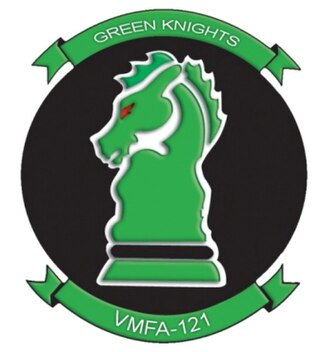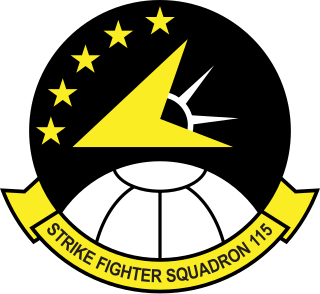The following were operators of the Grumman A-6 Intruder:
Contents

The following were operators of the Grumman A-6 Intruder:

In the 1990s, all Marine A-6E squadrons, except VMAT(AW)-202, were re-equipped with F/A-18D 'Night Attack' Hornet (including their recon-capable sub-version wired for ATARS) and re-designated to VMFA(AW). Due to the shortage of F/A-18D airframes in 2007 VMFA(AW)-332 was reduced to a "cadre status".

Naval Air Station Whidbey Island (NASWI) is a naval air station of the United States Navy located on two pieces of land near Oak Harbor, on Whidbey Island, in Island County, Washington.

Strike Fighter Squadron 211 (VFA-211), nicknamed the "Fighting Checkmates", is an aviation unit of the United States Navy established in 1945. The squadron is based at Naval Air Station Oceana and is equipped with the Boeing F/A-18E Super Hornet.

Fighter Squadron Composite 12 (VFC-12), also known as the "Fighting Omars", is a United States Navy Reserve fighter squadron based at NAS Oceana. It provides adversary training to East Coast Navy air wings. VFC-12 reports to Tactical Support Wing, a component of the Naval Air Force Reserve. The "Fighting Omars" are manned by selected reservists, full-time reservists (FTS) and active duty personnel.

A carrier air wing is an operational naval aviation organization composed of several aircraft squadrons and detachments of various types of fixed-wing and rotary-wing aircraft. Organized, equipped and trained to conduct modern US Navy carrier air operations while embarked aboard aircraft carriers, the various squadrons in an air wing have different but complementary missions, and provide most of the striking power and electronic warfare capabilities of a carrier battle group (CVBG). While the CVBG term is still used by other nations, the CVBG in US parlance is now known as a carrier strike group (CSG).

Marine Fighter Attack Squadron 121 (VMFA-121), also known as the "Green Knights", is a United States Marine Corps aircraft squadron operating the F-35B Lightning II. The squadron is based at Marine Corps Air Station Iwakuni, Japan and falls under the command of Marine Aircraft Group 12 (MAG-12) and the 1st Marine Aircraft Wing. Their tail code is VK and their radio call sign is "Combat".

Marine Fighter Attack Squadron 242 (VMFA-242) is a United States Marine Corps squadron flying F-35B Lightning II STOVL Stealth Fighter. The squadron, known as the "Bats", is based at Marine Corps Air Station Iwakuni, Japan and falls under the command of Marine Aircraft Group 12 (MAG-12) and the 1st Marine Aircraft Wing. The radio callsign is "Profane".

Strike Fighter Squadron 115 (VFA-115) is known as the "Eagles", callsign "Talon", a United States Navy F/A-18E Super Hornet strike fighter squadron stationed at Marine Corps Air Station Iwakuni. Their tail code is NF. It was established as Torpedo Squadron VT-11 on 10 October 1942, redesignated VA-12A on 15 November 1946, VA-115 on 15 July 1948, then finally VFA-115.

Strike Fighter Squadron 34 (VFA-34), also known as the "Blue Blasters", is a United States Navy F/A-18E Super Hornet strike fighter squadron stationed at Naval Air Station Oceana. They are a part of Carrier Air Wing 11 and are attached to the aircraft carrier USS Theodore Roosevelt. Their tail code is NH and their radio call sign is "Joker".

Attack Squadron 42 (VA-42) was a United States Navy attack squadron based at Naval Air Station Oceana, Virginia. The squadron was established as Fighter Squadron 42 (VF-42) on 1 September 1950, redesignated as VA-42 on 1 November 1953 and disestablished on 30 September 1994.

Strike Fighter Squadron 125 (VFA-125), also known as the "Rough Raiders", is a United States Navy strike fighter squadron based at Naval Air Station Lemoore, California. The "Rough Raiders" are a Fleet Replacement Squadron flying the F-35C Lightning II.

The Tactical Support Wing (TSW) is one of three reserve aircraft wings of the United States Navy. The wing reports to the Commander, Naval Air Force Reserve. It is headquartered at Naval Air Station Joint Reserve Base Fort Worth, Texas along with the reserve's Fleet Logistics Support Wing (FLSW). The third reserve wing is the Maritime Support Wing (MSW) which is headquartered at Naval Air Station North Island, California. The wing's primary mission is operational and training support for active forces. It is composed of five flying squadrons.

Fighter Squadron Composite 111 (VFC-111), also known as the "Sun Downers", is a United States Navy Reserve adversary squadron based at Naval Air Station Key West, Florida. Currently, it operates Northrop F-5N/F Tiger-IIs, of which most are single-seater F-5Ns and one twin-seater F-5F, the "FrankenTiger".

Strike Fighter Squadron 122 (VFA-122), also known as the "Flying Eagles", are a United States Navy F/A-18E/F Super Hornet and F/A-18 Hornet Fleet Replacement Squadron stationed at Naval Air Station Lemoore.

Electromagnetic Attack Squadron 133 (VAQ-133) is an EA-18G Growler squadron of the United States Navy based at Naval Air Station Whidbey Island, Washington. Beginning in 2013, the squadron began the transition from the EA-6B to the EA-18G. Upon completion of the transition in spring of 2014, they returned to their attachment to Carrier Air Wing Nine. The squadron's nickname is "Wizards" and its radio callsign is "Magic".

VAQ-33, nicknamed the Firebirds, was a Tactical Electronic Warfare Squadron of the U.S. Navy, serving for 44 years (1949–1993) under various designations and with a constantly-evolving group of aircraft. It was designated VAQ-33 in 1968, at which time it operated the piston-powered EA-1F Skyraider, or Spad. The squadron had the distinctions of being the last Navy unit to operate the Skyraider, and of making its last carrier deployment, in 1969. The retirement of the Spad marked the beginning of the squadron's decades-long role as a pioneering electronic aggressor squadron. That role ended with electronic aggressor mission's being transferred to the Navy Reserve and the squadron's disestablishment at NAS Key West on 1 October 1993.

VA-155 was an Attack Squadron of the U.S. Navy. It was established as Torpedo Squadron VT-153 on 26 March 1945. The squadron was redesignated as VA-16A on 15 November 1946, and finally designated as VA-155 on 15 July 1948. It was disestablished on 30 November 1949. Its nickname is unknown. It was the first squadron to be named VA-155, the second VA-155 was originally established in 1946, redesignated as VA-155 on 4 February 1953, and disestablished on 30 September 1977, while a third VA-155 was established on 1 September 1987 and disestablished on 30 April 1993.

Attack Squadron 196 (VA-196) was an aviation unit of the United States Navy. It was established as Fighter Squadron 153 (VF-153) on 15 July 1948, redesignated as VF-194 on 15 February 1950, and finally redesignated VA-196 on 4 May 1955. Its nicknames were the Thundercats from 1948 to the 1950s, and The Main Battery from the 1950s thereafter. Beginning in 1979 the squadron used the nickname Milestones interchangeably with Main Battery. The squadron was disestablished on 21 March 1997, after more than 48 years of service.
In 1989, the United States Navy was on the verge of massive cuts to military spending cuts including ship and aircraft procurement. These forces were expected to fight the Soviet Union, Warsaw Pact and other potential adversaries in case of a war breaking out. At this time, the USS Kitty Hawk (CV-63) of the Pacific Fleet was out of commission for Service Life Extension Program (SLEP) modernization leaving the 3rd Fleet with less carriers.

Electromagnetic Attack Squadron 144 (VAQ-144), “Main Battery", is a United States Navy aircraft squadron based at Naval Air Station Whidbey Island, flying the EA-18G Growler.